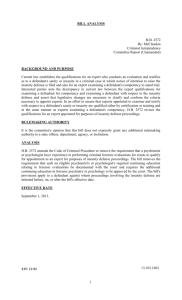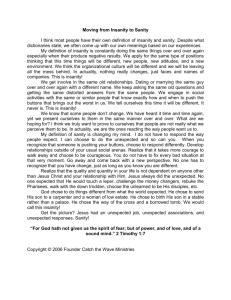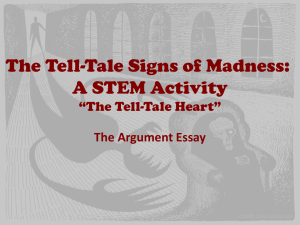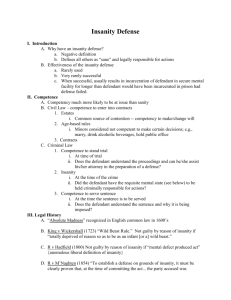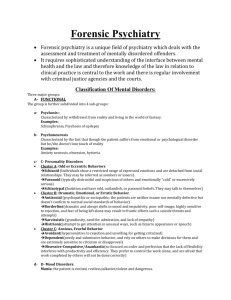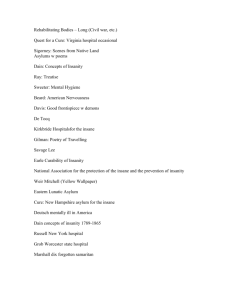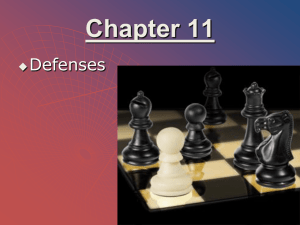Journal of Psychiatry & Law
advertisement
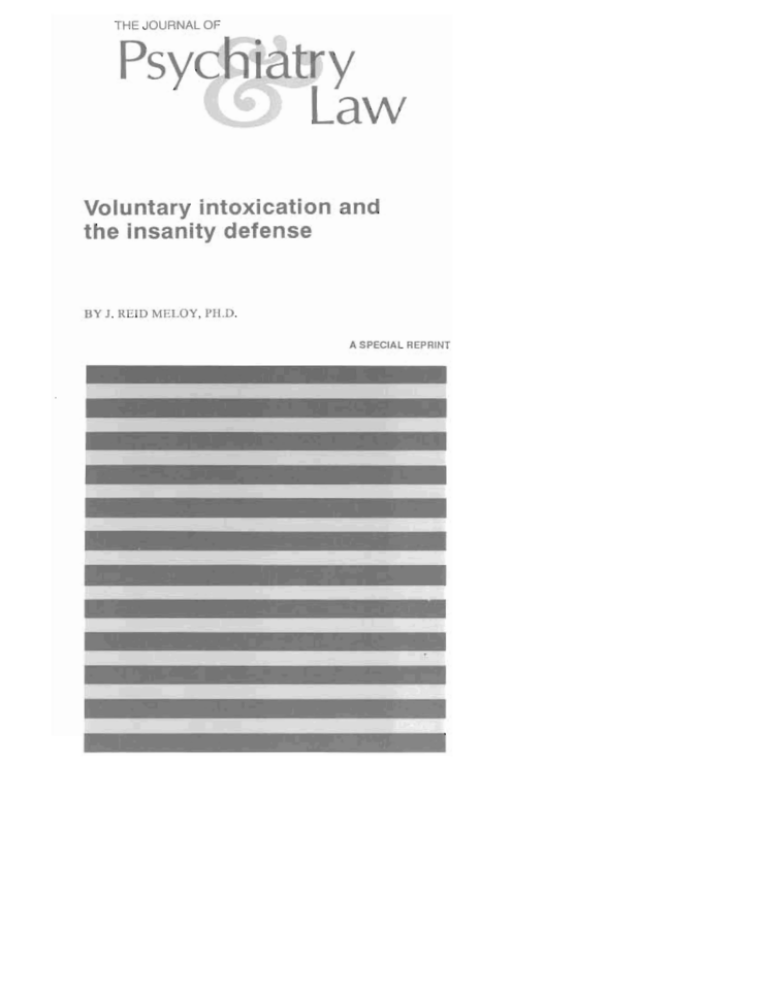
H JOURNALOF Vo n ·ary in oxica·o t e· ns nity defense an BY J. REID MELOY, PH.D. A SPECIAL REPAINT The Journal of Psychiatry & Law/Winler 1992 439 Voluntary intoxication and the insanity defense BY J. REID MELOY, PH.D. Voluntary intoxication can be used as a basis for the insanity defense in certain cases. I review the obscure concept of "settled insanity" in California case law and note its lOO-year evolution from a "permanent" state of mind, usually associated with chronic alcoholism, to a current test of temporary insanity wherein the mental disorder must be fixed, stable, of reasonable duration, and not solely dependent upon the ingestion or duration of the drug. I argue that this definition is tautological and arbitrary and propose a new definition of "settled insanity" based only upon a demonstrated predisposition to psychosis. This definition is consistent with current scientific research concerning psychosis­ proneness in individuals who become paranoid and delusional through the use ofpsychostimulants, the class of drugs now most likely to contribute to a voluntary intoxication-insanity defense strategy. AUTHOR'S NOTE: A portion of this paper was first presented pt the Ameri­ can Academy of Psychiatry and the Law, October 22, 1988, in San Fran­ cisco, California. Author correspondence: 964 Fifth Ave., Suite 435, San Diego, CA 92101, tel. 619-544-1435. C> 1993 by Federal Legal Publica/ions, Inc. 440 VOLUNTARY INTOXICATION Following the legal and social upheaval surrounding the acquittal by reason of insanity of John W. Hinckley, Jr., and the brief public consternation over the Jeffrey Dahmer plea, the defense of insanity has once again receded into the socio­ political background. The State of California, for example, returned to the M'Naghten test' after a four-year (1978-82) liberalization of the defense under the Model Penal Codez and ensured stability by legislating that two-thirds of the state senate and assembly would need to affirmatively vote to change the statute again. 3 Despite the periodic historical controversy whenever the insanity defense is entered in a well publicized criminal trial,4 it remains the quintessential legal statement in 47 of the 50 states that some individuals, due to a mental disorder, should not be held responsible for their actions regardless of the nature of their crime. Although successfully used in only one­ quarter of 1 % of felony indictments,s the insanity defense is a continual reminder of the necessity of mens rea, the guilty mind, in our criminal law. It is, in a sense, the exception that provides the jurisprudential rule that a guilty mind must exist for a criminal act to occur. Cumulative psychiatric and psychological research during the past several decades has also supported this implicit moral belief that some individuals with a mental disorder should not be held responsible for their actions because the nature and extent of their mental disorder are beyond their voluntary control,6 Disorders outside the parameters of functional psy­ choses are much more controversial when argued as the basis for an insanity defense, primarily due to the question of per­ sonal choice and responsibility.7 This question of personal choice and insanity comes.into bold relief when voluntary intoxication and the insanity defense are considered. To what extent should society excuse criminal behavior that is the result of the voluntary ingestion of psy­ choactive drugs? If an individual is chronically abusing psy­ 441 choactive drugs, is there a psychobiological point at which a mental disorder exists independently of the ingestion of the drug and therefore should be considered as a basis for an insanity defense? Or, on the other hand, should an insanity defense be ruled out if the voluntary ingestion of psychoac­ tive drugs was a causative factor in the genesis of the mental disorder, regardless of the current state of the mental disor­ der? My intent in this article is to shed some light on these ques­ tions by reviewing the history of and critiquing the present status of voluntary intoxication and the insanity defense. I will focus upon the concept of "settled insanity" in California criminal law. This lOO-year-old legal doctrine has a remark­ able yet obscure history that is little known even to scholars of the insanity defense. Settled insanity The legal concept of "settled insanity" represents the uneasy convergence of a social belief and a social fact: some individ­ uals should not be held responsible for their criminal actions because they did not know that what they were doing was wrong, yet some of these individuals voluntarily abrogate responsibility through the ingestion of certain intoxicating substances. "Settled insanity" becomes the legal point at which voluntary behavior creates a state of mind that negates culpability for criminal behavior. I am using "state of mind" in a psychological rather than a legal sense. I would define the term as a present mental state characterized by certain thoughts, emotions, and perceptions of internal and external reality. The first definition of "settled insanity" in California law appeared in People v. Travers,8 a case in which the accused, a 19th-century California cowboy, had been found guilty of murder. The court wrote, ". . . it is sufficient to say that 442 VOLUNTARY INTOXICATION settled insanity produced by a long-continued intoxication affects responsibility in the same way as insanity produced by any other cause. But it must be 'settled insanity,' and not merely a temporary mental condition produced by recent use of intoxicating liquor" (pp. 239-240, italics mine). People v. Fellows9 expanded and refined the definition: "If one, by reason of long-continued indulgence in intoxicants, has reached that stage of chronic alcoholism where the brain is permanently diseased, where the victim is rendered incapable of distinguishing right from wrong, and where permanent general insanity has resulted, then, and in such case, he is no more legally responsible for his acts than would be the man congenitally insane, or insane from violent injury to the brain" (p. 240, italics mine). People v. Findleylo subsequently upheld the instructions of the court to the jury when it wrote, "When temporary or spas­ modic insanity is proved to have existed prior to the commis­ sion of a criminal act, there is no presumption of its continuance down to the specific time of the criminal act. To establish the basis of a presumption that insanity, once shown to have existed, continues to exist, it must appear to have been of such duration and character as to indicate the proba­ bility of its recurrence" (p. 307). People v. Hower ll became the last in this series of turn-of-the-century California cases that reiterated the opinion of the previous cases, and it drew further support from a New York case, People v. Rogers,l2 from which it quoted directly: If it (the inestimable gift of reason) is perverted or destroyed by fixed disease, though brought on by his own vices, the law holds him not accountable, but if, by a voluntary act, he temporarily casts off the restraints of reason and conscience, no wrong is done him if he is considered answerable for any injury which, in that state, he may do to others or to society. The initial case law precedent was clear: settled insanity held within it the notion of permanency, which implied both a temporal dimension to the mental disorder ("long-continued 443 intoxication. . . long-continued indulgence. . . probability of its continuance") and a separation of the mental disorder from the intoxicant ("permanently diseased . . . permanent general insanity . . . perverted or destroyed by fixed dis­ ease"). Unfortunately this notion of permanency violated the rule that temporary insanity as a defense was as fully recognized by law as permanent insanity.13 Subsequent cases avoided this legal contradiction. 14 People v. Wolff' addressed the notion of permanent insanity, but not in relationship to settled insanity. The court ruled in Wolff that there was no conflict between a jury instruction that the defendant was presumed sane and an instruction that proof of permanent insanity before the crime was committed raises a presumption that the defendant's insanity existed at the time of the crime. The court's opinion in this case is helpful in my analysis of permanency as it relates to insanity. The court opined that admission of a defendant's mental capacity prior to the commission of a crime is admissible as an inference of fact: . . . It is merely one illustration of the broader proposition that "when the existence of an object, condition, quality, or tendency at a given time is in issue, the prior existence of it is in human experi­ ence some indication of its probable persistence or continuance at a Later period." [Wigmore, Evidence (3d ed. 1940) Section 437.] (Weihofen, Mental Disorder as a Criminal Defense (1954) p. 230 [fns. omitted].) The latter proposition is codified in our law as a "disputable presumption" (Code Civ. Proc., Section 1963 subd. 32 ["That a thing once proved to exist continues as long as is usual with things of that nature"]). This inference of fact becomes a critical point of departure when linking the effects of psychopharmacological sub­ stances upon mental states, both their temporal proximity to the insane act and their capacity to establish a mental defect independent of the eventual metabolism of the drug and its excretion from the body. It is critical, that is, if permanency is considered a central element of settled insanity. 444 VOLUNTARY INTOXICATION This contradiction between permanency as a necessary ele­ ment of settled insanity and the legal standard that temporary insanity was as recognizable a defense as permanent insanity was not directly addressed by a California court until People v. Kelly in 1973. 16 In Kelly the California Supreme Court ruled that it was prejudicial error to require proof that the defendant's insanity was permanent as well as settled. Such a requirement violated the rule that temporary insanity as a defense to a crime was as fully recognized by law as perma­ nent insanity. Defendant Valerie Dawn Kelly was found guilty of assault with a deadly weapon (California P.c. Section 245[a]) and legally sane at the time of her offense by a San Diego County superior court. Ms. Kelly had been using various drugs since the age of 15. In the fall of 1970, when she was 18 years old, she began using mescaline and LSD, ingesting these potent hallucinogenic drugs 50-100 times in the months leading up to her offense. On December 6, 1970, after her parents took custody of her from a Los Angeles police substation-she had been found wandering about the Los Angeles Interna­ tional Airport-they drove her back home to San Diego. The next morning, Valerie Kelly called her mother and asked if she could come to their home. Mrs. Kelly had her daughter change into pajamas and made her breakfast. Shortly there­ after, Valerie Kelly entered the kitchen and stabbed her mother repeatedly with a variety of kitchen knives. Psychi­ atric reports described Valerie's psychotic state at the time: she thought that her parents "were with the devils" and "real­ ized that something was going to die-that they were going to kill me."17 Psychiatric testimony was essentially in agreement that Valerie Kelly had a schizoid personality disorder and for a period of two months preceding the offense was also suffer­ ing from pathological intoxication due to the chronic inges­ tion of hallucinogenic drugs. 18 The drug abuse was deemed 445 the indirect cause of a legitimate, although temporary, psy­ chosis that would remain even when the defendant was not ingesting the drugs. Nevertheless, the Superior Court ruled that an insanity plea was no defense because it "was not of a settled and permanent nature, and, in addition, was produced by the voluntary ingestion of hallucinatory drugs" (italics mine).19 The California Supreme Court reversed the Kelly ruling because the trial court required that the defendant's insanity be both settled and permanent. It stated that to require perma­ nency is to violate the rule that "temporary insanity as a defense to crime is as fully recognized by law as is permanent insanity."20 The court, however, also acknowledged that pre­ vious decisions had left the impression that a defendant must be permanently insane, but this conclusion was incorrect. 21 The only legitimate test was that the insanity was "settled," and this was defined by the court: "When long-continued intoxication results in insanity, however, the mental disorder remains even after the effects of the drug or alcohol have worn off."22 It also opined that it makes no difference "whether the period of insanity lasted several months. . . or merely a period of hours" and further stated that the defen­ dant "did not lose the defense of insanity because she may also have been intoxicated at the time of the offense."23 The Kelly decision was applauded as a well reasoned and clearly presented opinion that clarified the issue of drug­ induced insanity.24 It had eliminated the contradictory notion of permanency; but "settled" still remained a rather ambigu­ ous term, especially since the court had not distinguished between "mental disorder" and "effects of the drug or alco­ hol," it had not applied any temporal dimension to the term, and it had allowed concurrent intoxication to exist at the time of the offense despite the defense claim of insanity. Subsequent cases wrestled with the definition of "settled." People v. Wagoner 25 affirmed the conviction of a heroin 446 VOLUNTARY INTOXICATION addict who had furnished drugs to a minor and ruled that vol­ untary intoxication as a complete defense to a general intent crime could be claimed only if the mental disorder extended beyond the period of intoxication; in the case at bar, "appel­ lant's mental defect dissipated after his intoxication wore off. • • ."26 The court also opined that the 1978 shift in California from the M'Naghten to the American Law Institute standard of insanity did not affect the concept of settled insanity. 27 In People v. Schneider 28 the court stated once again that insanity must outlast the intoxicated state. And People v. McCarth y 29 two years later offered the most colorful reitera­ tion of the Kelly decision: In other words, your friendly local lush cannot get sloshed, commit a horrendous crime and slip into a state hospital free from criminal sanctions. If an alcoholic wants to use his problem as an escape hatch, he must drink enough to develop a mental disorder that con­ tinues when he is stone sober even though the damage is not perma­ nent in the sense it is beyond repair. Kelly offers us the escape from a completely absurd situation in which those who produce distorted mental conditions by the use of such mind-benders as acid, speed, angel dust or alcohol, then commit bizarre, dangerous and ugly acts could escape criminal sanctions. 30 But the nature of "settled" still remained ambiguous, and it became more crucial with the increased use of psychostimu­ lants such as cocaine and methamphetamine-substances that could induce paranoid states when ingested and thus heighten the risk of violent behavior. "Settled" could easily become a loophole if the Kelly phrase "a period of hours"3! was taken literally as a minimal time frame for the mental disorder resulting from the voluntary ingestion of a drug. People v. SkinnerJ2 closed the loophole in 1986, at least in California. Raymond Skinner was admitted to Oakcrest Hos­ pital on July 19, 1983, pursuant to California We"uare and Institutions Code Section 5150, a 72-hour involuntary deten­ tion statute for mentally ill persons who are a danger to self or others or are gravely disabled. Skinner was paranoid and 447 agitated, but he slept through the night and was discharged the next morning. That evening the defendant and his wife of 29 years, Mary Anne Skinner, checked into the Town House Motel in Santa Rosa, California. Defendant later reported to police that he free-based cocaine all night with his wife until 5 a.m. the next morning, July 21. Raymond Skinner drove away from the motel room by himself around noon and was shortly thereafter observed by a California Highway Patrol officer to drive his car through a center divider, stop the vehi­ cle, and walk between lanes of oncoming traffic. The officer approached him, and he said, "Kill me. I want to die . . . I killed my wife . . . I want you to kill me."33 He stated that he had slit his wife's throat in the Town House Motel, and subsequent investigation confirmed this. Mary Anne Skinner had apparently been struck on the forehead with a bottle, struck again on the back of the head, and then slashed twice on the neck with the broken bottle. Raymond Skinner was arrested and charged with murder. His blood contained .03 milligrams per milliliter of cocaine at 2:20 p.m., approximately three hours after the killing. He exhibited signs and symptoms of cocaine intoxication but did not evidence symptoms of cocaine delirium or cocaine­ induced delusions when arrested. 34 Psychiatric and psychological testimony, although essentially in agreement that Raymond Skinner was in the throes of a "toxic psychosis" caused by the ingestion of cocaine at the time of his wife's killing, did not include speculation about the duration of the psychosis, either before or after her death. There was, however, a surprising, if unsubstantiated, clinical consensus that the defendant was legally insane at the time of the killing as defined by the M'Naghten standard. Two physi­ cians testified to the probable five- to seven-day duration of a cocaine psychosis following last ingestion of the drug. 3s The trial court found that Raymond Skinner was guilty of second degree murder. On the question of insanity, the court 448 VOLUNTARY INTOXICATION found that the defendant did not meet either M'Naghten prong of the insanity defense, and furthermore, his psychosis was brought on by the voluntary ingestion of drugs and was not "settled."36 The court of appeal affirmed the conviction. Concerning the issue of "settled" insanity, it made several important rulings. First, appellant's reliance on the Kelly phrase "a period of hours" to support his claim of settled insanity was rejected because that language had no relation to the facts in Kelly, and "to the extent its dictum is inconsistent with the court's holding, it must be disregarded."37 Second, and most importantly, the court rejected appellant's theory that insanity is "settled" if it lasts any longer than the time the drug that induced it remains in the defendant's body. The court wrote: There was substantial evidence presented to the trial court from which it could properly infer that appellant's condition, even if it could be characterized as "insanity," was merely a temporary one produced by recent use of cocaine. The court said, "It appears logi­ cal that settled must mean fixed and stable for a reasonable dura­ tion and not solely dependent on the recent injection or ingestion and duration of the effects of the drug. Here the testified-to psy­ chosis is directly related to the recent ingestion and duration of the effect of the drug. The onset of the psychosis by the testimony of all the doctors was a result of the ingestion of the free base cocaine and the duration was transitory and related to the cessation of the drug's influence although it may have extended slightly beyond that influence for from five to seven days." . . . The court correctly applied the proper rule of law to the facts before it. (italics mine, 185 Cal. App. 3d at 1063) Skinner introduced four criteria for defining the "settled" nature of an insanity defense: the disorder must be fixed, it must be stable, it must last for a reasonable duration of time, and it must not be solely dependent on the ingestion and duration of the drug. Only then can the M'Naghten definition 449 of insanity be applied to the mental state at the time of the offense. Discussion The history of voluntary intoxication and the insanity defense in California began with a definition of "settled insanity" based upon the concept of "permanency" that was applied to alcohol-induced organic brain syndrome. Over the past 100 years it has evolved into a four-pronged test as defined by Skinner, which includes both temporal and causal dimen­ sions. But problems remain. The court has attempted to steer a pre­ carious temporal course between the Scylla of "transitory duration" and the Charybdis of "permanency" without violat­ ing the legal equivalency of temporary and permanent insan­ ity. Drug intoxication is not enough for settled insanity, but demanding an unreasonable duration of time for the person to be in a mental state that rises to the threshold of insanity would violate this equivalency doctrine. The Skinner court addressed this problem by defining the ambiguous term "set­ tled" with two further semantically ambiguous and clinically meaningless terms, "fixed" and "stable." All three terms share the synonyms "permanent" and "unchanging." The court thus substituted semantically equivalent words and acted as if it was creating new distinctions when, in fact, nothing was clarified. The court also attempted to address the causal question by requiring that the mental state not be "solely dependent" on the ingestion and duration of the drug. This is a valiant attempt to separate the "insane" mental state from just the drug's effects, but it is a clinically very difficult "question to answer. There is no clinical interview technique, psychologi­ cal test, or central nervous system measure (CAT scan, PET scan, MRI, EEG, etc.) that can retrospectively sort out the .. 450 VOLUNTARY INTOXICATION various factors that cause a mental state and weigh their con­ tribution, whether drug related or not, to a criminal act. The question would fall, as is often the case when the law reaches and psychiatry attempts to grasp, to the speculation of retained experts. 38 I would propose, instead, that courts turn to the scientific lit­ erature for direction 39 to formulate a judicial principle that can then be applied to the facts in anyone particular case. This is most easily illustrated by focusing upon psychostimu­ lants, a class of drugs that may directly cause delusions when used chronically. I have chosen stimulants, most notably cocaine and amphetamine, because of their wide social use,40 their link to criminal activity,41 their role in causing paranoid delusions,42 and the virtual necessity of delusions in affirming an insanity defense. 43 Scientific research has documented the induction of paranoid psychosis by psychostimulants for many years. 44 Researchers are now addressing the question of whether subjects who become paranoid while using psychostimulants are predis­ posed to the development of such psychosis in the absence of pharmacologic stress. The probable answer is Yes. Tsuang, Simpson, and Kronfol 4s found that substance abusers who subsequently developed psychoses had premorbid histories and symptoms comparable to those of schizophrenic patients, while a comparison group of drug abusers who subsequently did not develop psychoses used drugs without psy­ chotomimetic properties. Bowers and Swigar 46 found that acutely psychotic patients who had used hallucinogens within three years of admission were more sensitive to psychosis if they had positive family histories of mental illness. Brady et al. 47 found that schizophrenic patients who abused cocaine were significantly more likely to be diagnosed.paranoid schizophrenic than those schizophrenic patients who did not abuse cocaine. These researchers and others have hypothe­ sized that subthreshold psychotic symptoms may actually influence the individual's selection of drugs, and that symp­ 451 toms associated with psychotic disorders were present prior to the drug use but were subclinica1. 4B Satel and Ede1l 49 found in a sample of 20 cocaine-dependent men that those who developed paranoia had significantly correlated elevations on two measures of psychosis proneness: the Perceptual Aberra­ tion Scale and the Magical Ideation Scale. They wrote: "The present study provides evidence that individuals who experi­ ence transient cocaine-induced paranoia report symptoms, occurring in the drug-free state, that are associated with psy­ chosis proneness" (p. 1710). They further speculated that these individuals may have a subclinical vulnerability in the dopaminergic system, upon which chronic cocaine use has been shown to have substantial effects.'o I would propose, consistent with current scientific research, that the concept of "settled insanity" be limited to cases in which a predisposition to psychosis can be substantially demonstrated. In other words, but for the presence of a vul­ nerability to psychosis, "settled insanity" would not apply. The retrospective clinical issues are difficult, but not impos­ sible, to answer. A premorbid history of mental illness, a familial history of mental disorder, psychiatric data prior to the ingestion of drugs, and psychological testing could be used as evidence to show such vulnerability. Such an approach by the courts would eliminate the tautolog­ ical problems of defining "settled," avoid the arbitrary deci­ sion surrounding a "reasonable" duration of time, and flush out other factors that contributed to the mental state beyond the ingestion and duration of the drug. The absence of a pre­ morbid history, family history, psychiatric data prior to the drug use, or psychological test results would eliminate con­ sideration of an insanity defense in a case of voluntary intoxi­ cation, even if the individual had a diagnosable psychotic disorder at the time of the crime that fit the jurisdiction's def­ inition of "insanity."'l 452 VOLUNTARY INTOXICATION This approach to the law also attenuates the volitional thorn of "settled insanity": how can an individual who voluntarily took drugs be found insane? Despite the individual's volun­ tary ingestion of drugs, his biological proneness to psychosis is beyond his volitional control and therefore becomes the most salient factor in his exculpation. His chronic drug use does not, and thus it cannot be used to avoid responsibility for the crime. This proposal, however, is not without its problems. Although five studies have been cited that support a relation­ ship between measurable psychosis proneness and subsequent psychotic symptoms following the use of psychostimulants, it is arguable that there is not yet a sufficient scientific basis for such testimony. Furthermore, by limiting the data gathering to more overt measures of individual or familial mental disor­ der before the drug use, is there not a substantial risk of false negatives? That is, individuals who were psychosis prone would be clinically labeled as not psychosis prone due to a lack of measurement sensitivity. The evaluation of such a risk of error, which would favor the prosecution, is beyond the reach of the extant research on psychosis proneness. To risk a research cliche, further work needs to be done. Notes 1. The so-called "Victims' Bill of Rights" reinstituted the M'Naghten standard in 1982; the conjunctive and, however, was substituted for or in California P.C. Section 25(b), which essentially toughened the standard by requiring both prongs of the insanity defense to be met by the defendant. The and was subsequently ruled to not have been the intent of the legislature (People v. Skinner, 39 Ca1.3d 765 (1985), and the disjunctive or, once again, became the law of the land. 2. The American Law Institute's standard for the insanity defense, which adds a disjunctive volitional prong of conformance to the law to a cognitive prong, became effective in California with People v. Drew, 22 Ca1.3d 333 (1978). 3. California P.e. Section 25(d). 4. See R. Rogers, Conducting Insanity Evaluations (New York: Van Nostrand Reinhold, 1986) for an excellent review of the history of 453 the insanity defense; see also A. Goldstein, The Insanity Defense (New Haven: Yale University Press, 1967), which has become a classic text in the debate, and N. Morris, Madness and the Criminal Law (Chicago: University of Chicago Press, 1982) for an incisive discussion of the relationship between mental illness and the criminal-law power of the state. 5. Callahan, L., Steadman, H., McGreevy, M., Robbins, P. The volume and characteristics of insanity defense pleas: an eight state study. Bulletin of the American Academy of Psychiatry and the Law 19:331-338,1991. 6. Research concerning the major functional psychoses is one example: various forms of bipolar affective disorder and schizophrenia are now considered to be primarily genetically loaded, inherited disorders with certain patterns of familial transmission. The central treatment for both disorders is pharmacotherapy, not psychotherapy, although the latter is seen as an important component of successful treatment. 7. See D. Hermann, Criminal defenses and pleas in mitigation based on amnesia. Behavioral Sciences and the Law 4, 1, 5-26, 1986; N. Finkel and S. Sabat, Split-brain madness: An insanity defense waiting to happen. Law and Human Behavior 8, 3/4, 225-252, 1984; and E. Howe, Psychiatric evaluation of offenders who commit crimes while experiencing dissociative states. Law and Human Behavior 8, 3/4, 253-282, 1984. The latter article raises the interesting question of multiple personality and criminal responsibility. If the one subpersonality accused of committing the crime is successfully treated prior to prosecution and hence is no longer behaviorally identifiable, who would be left to prosecute? 8. 88 Cal. 233 (1891). 9. 122 Cal. 233 (1898). 10. 132 Cal. 301 (1901). 11. 151 Cal. 638 (1907). 12. 18 N.Y. 9 (72 Am. Dec. 484). 13. People v. Ford, 138 Cal. 140 (1902). See also: People v. Donegan (1939), Cal. App.2d 716, 719 [90 P.2d 856], where the court wrote, " . . . if you believe from the evidence . . . that the defendant, at the time she committed the homicide, was temporarily insane within the meaning of the law, then regardless of whether the defendant was sane before or after the time when the acts were committed, it is your duty to bring in a verdict that defendant was insane at the time of the commission of the offense." 455 26. 89 Cal. App.3d at 614. 27. 89 Cal. App.3d at 614. 28. 95 Cal. App.3d 671 (1979). 29. 110 Cal. App.3d 296 (1980). 3D. 111 Cal. App.3d at 299, 300. 31. 10 Cal.3d at 577. 32. 185 Cal. App.3d 1050 (1986). 33. 185 Cal. App.3d at 1053. 34. This is my opinion based upon the facts as presented in the appellate case; it must be viewed as quite tentative. 35. 185 Cal. App.3d at 1056-1059. The current diagnosis most applicable to the experts' opinions in this case is "Cocaine Delusional Disorder" (Diagnostic and Statistical Manual of Mental Disorder Ill-Revised, American Psychiatric Association, 1987, pp. 143-144). The predominant symptoms are rapidly developing persecutory delusions appearing shortly after use of cocaine. DSM­ III Revised, however, states that "delusions can linger for a week or more, but occasionally last for over a year" (p. 144). A recent study found a 68% incidence of "highly distressing transient paranoid states" (p. 495) in a sample (N=50) of cocaine-dependent men. Paranoia increased with continued cocaine use. Affected individuals may possess a predisposition to paranoia through limbic sensi­ tization. See S. Satel, S. Southwick, and F. Gawin, Clinical features of cocaine-induced paranoia. American Journal of Psychiatry 148, 4, 495-498, 1991. 36. 186 Cal. App.3d at 1059. The M'Naghten Standard in California reads as follows: " . . . he or she was incapable of knowing or understanding the nature and quality of his or her act and of distinguishing right from wrong at the time of the commission of the offense." (California Penal Code Section 25[b]) 37. 185 Cal. App.3d at 1062. 38. See I. Perr, Alleged brain damage, diminished capacity, mens rea, and misuse of medical concepts. Jourllal of Forensic Sciences 36:722-727, 1991; Meloy, R. (letter to the editor). Journal of Forensic Sciences 37:370-371, 1992; Perr, I. (autho'r's response). Journal of Forensic Sciences 37:371-372,1992. 39. See J. Monahan and L. Walker, Social Science in Law: Cases and Materials: Second Edition, Mineola, NY: Foundation Press, 1990, 456 VOLUNTARY INTOXICATION for a comprehensive treatment of social science as an analytic tool of the law. 40. Gawin, F. and Kleber, H. Cocaine abuse in a treatment population: Patterns and diagnostic considerations. NIDA Research MO/lograph 61:182·193,1985. 41. See the Drug Use Forecasti/lg Study published by the National Institute of Justice (Charles B. DeWitt, director) for a quarterly research update on the strong association between criminality and the use of illegal drugs. For instance, in the first quarter of 1991, 79% of male arrestees in San Diego tested positive by urinalysis for an illicit drug, excluding alcohol. Forty-one percent tested positive for cocaine. The highest cocaine-positive group was in Manhattan (64%). Such studies, of course, cannot speak to a causal relation, in either direction, between drugs and crime. 42. Gawin, F. and Ellinwood, E. Cocaine and other stimulants. New E/lgla/ld Journal of Medicille 313:1173-1182, 1988. 43. Supra note 4. 44. Connell, P. Amphetamille Psychosis: Maudsley MOllograph 5. New York: Oxford University Press, 1958. 45. Tsuang, M., Simpson, J., and Kronfol, Z. Subtypes of drug use with psychosis: Demographic characteristics, clinical features, and family history. Archives of Gelleral Psychiatry 39:141-147,1982. 46. Bowers, M. B. and Swigar, M. E. Vulnerability to psychosis associated with hallucinogen use. Psychiatry Research 9:91-97, 1983. See also: Meloy, J. R. Thought organization and primary process in the parents of schizophrenics. British Journal of Medical Psychology 57:279-281,1984. 47. Brady, K., Anton, R., Ballenger, J. C., Lydiard, B., Adinoff, B., and Selander, J. Cocaine abuse among schizophrenic patients. America/l Journal of Psychiatry 147: 1164-1167,1990. 48. McLellan, A. T., Woody, G. E., and O'Brien, C. P. Development of psychiatric illness in drug abusers. New Ellglalld Jour/lal of Medici/le 301:1310-1314, 1979. 49. Satel, S. and Edell, W. Cocaine-induced paranoia and psychosis proneness. America/l Journal of Psychiatry 148:1708-1711, 1991. 50. Ritz, M. C., Lamb, R. J., Goldberg, S. R., and Kuhar, M. J. Cocaine receptors on dopamine transporters are related to self-administration of cocaine. Scie/lce 237:1219-1223,1987. 457 51. "Settled insanity" must first be established before it can be applied to the relevant sanity test definition. For example, a defendant found to have a mental state that met the current definition of "settled insanity" (fixed and stable) would then have to demonstrate by a preponderance of the evidence that his mental state resulted in his incapability of knowing or understanding the nature and quality of his act or of distinguishing right from wrong at the time of the crime. See note 36, supra.
